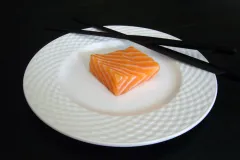Love Salmon? Listen Up.

Salmon are one of the most widely loved varieties of seafood in the world. A ubiquitous alternative to meat and poultry, salmon wear a halo of healthfulness, as they are rich in protein and omega-3 fatty acids. But many wild salmon stocks are dwindling, which means that unless otherwise specified, the salmon you’re most likely to find in restaurants and stores is from a farm.
Wild Atlantic salmon once ranged from Portugal to Newfoundland and in every major river north of the Hudson, but they have disappeared from many waterways and are in danger of going extinct within our lifetime. Meanwhile, domesticated Atlantic salmon are increasingly populous in offshore cages in countries including Norway, British Columbia, and Chile.
In November, I traveled to Chilean Patagonia where more than 1,500 salmon farms have applied for permits to operate in the coming year. There are currently only eight farms operating in the region, and many people I spoke to worry that an influx of farmed salmon could spell trouble for Patagonia’s marine environment and growing tourism economy.
So what’s the problem? Here are the most important potential issues with Chilean farmed salmon—much of which is destined for the United States:
- Pollution: Fish waste and excess feed can cause rapid algae growth that pollutes the water surrounding aquaculture pens, and can create oxygen-deprived dead zones. The waste collects under net pens, polluting the seafloor and surrounding waters.
- Disease: The crowded conditions of salmon farming pens provide ideal conditions for the outbreak of parasites and disease, such as infectious salmon anemia, which caused the collapse of the industry in Chile in 2007. As a result, the industry often uses high doses of pesticides and antibiotics on the fish, including some antibiotics that are meant for use only in humans.
- Escapes: Millions of farmed salmon escape into the environment each year, where they can spread disease and compete with, or even prey on, wild fish.
- Overfishing: Carnivorous farmed salmon are often fed wild-caught fish, competing directly with humans and other species for this diminishing resource. In Chile, it can take eight kilograms (nearly 18 pounds) of fish from the world's oceans to produce one kilogram (roughly two pounds) of farmed salmon. Some of the fisheries that feed salmon—anchoveta, sardines, jack mackerel—are now becoming overexploited as a result, which is bad news for the entire ocean food chain.
- Colorants: Farmed salmon are dyed "salmon" color because their natural color would be grayish from their artificial diet. Wild salmon, which are still thriving in some parts of the Pacific Northwest and Alaska, get their color from eating tiny shrimp-like krill and other tiny shellfish.
These issues are important considerations in all aquaculture operations, and, just like catching wild fish, there are better and worse ways to go about it. Scientists in Puerto Rico, for example, are studying ways to make aquaculture sustainable by looking at which environmental factors (location, depth, currents, etc.) can help reduce pollution and other impacts of fish farms.
During my stay in Patagonia, I caught a boat out of Puerto Natales, Chile, a picturesque town that thrives on eco-tourism in the warmer months. Against a backdrop of snow-covered peaks, I caught sight of the docks and brightly-colored buoys that comprise a salmon farm. I smelled no harsh odor, heard no noise pollution, and the salmon themselves were hidden from sight underwater. But despite the farm’s outwardly tranquil appearance, the addition of thousands of non-native fish into the clean waters of Patagonia would undoubtedly have an impact.
I love to eat salmon as much as the next person, but knowing the toll they take on marine ecosystems in Chile and elsewhere, now I ask more questions before I order. So the next time you’re in the mood for salmon, pause for a moment and consider its origin.
Editor’s Note: To learn more about making smart seafood choices—salmon or otherwise—explore the Ocean Portal’s Sustainable Seafood section.

